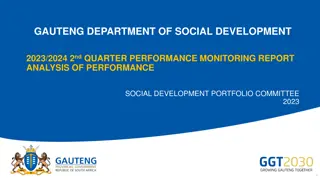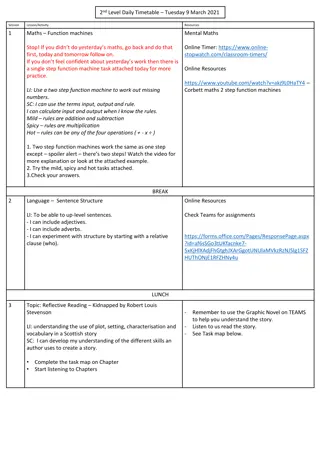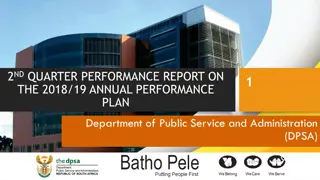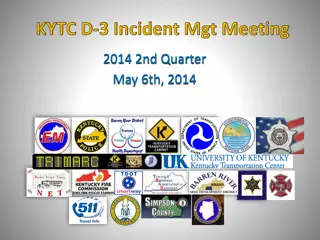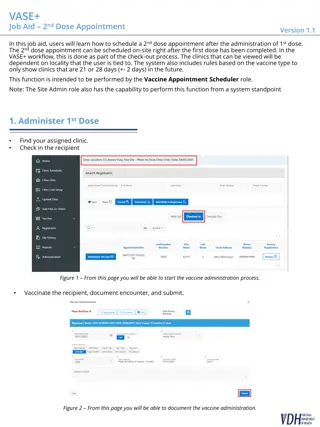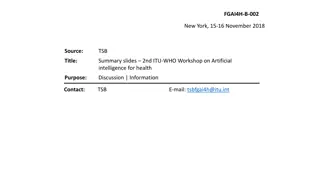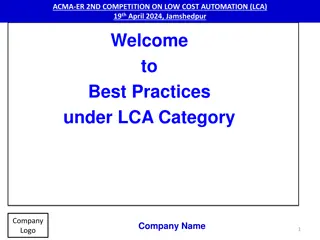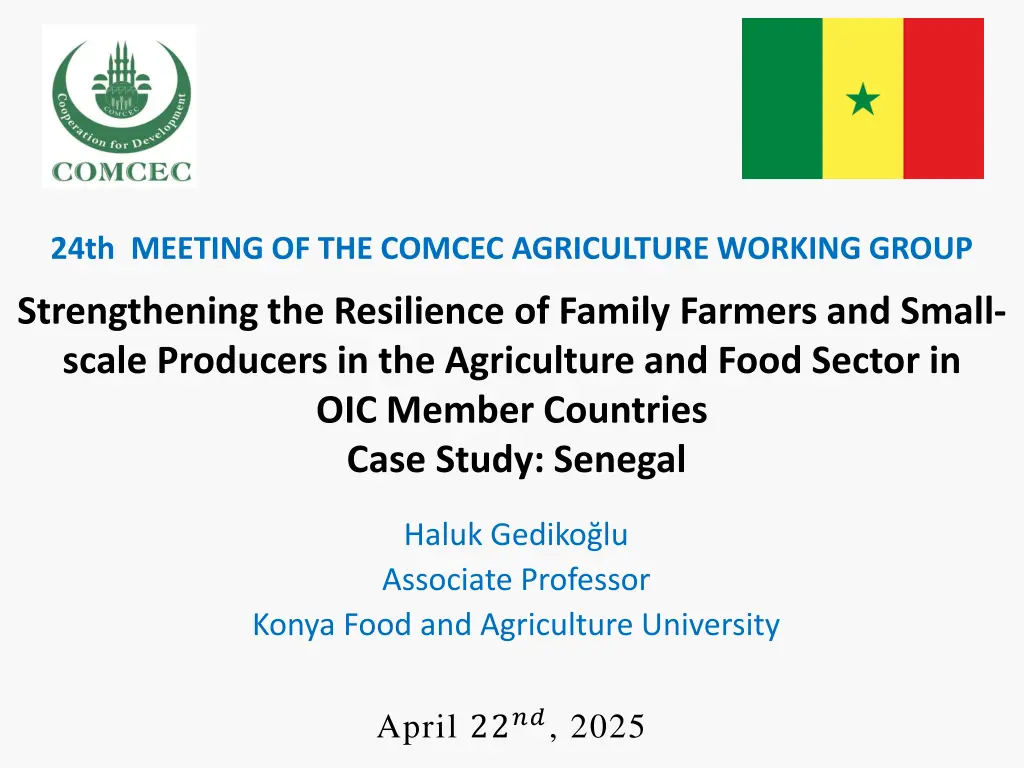
Strengthening Resilience of Family Farmers in Senegal through Agricultural Production Analysis
Explore a case study on measuring and influencing resilience in family farmers in Senegal, providing policy recommendations for enhancing their agricultural production resilience. Learn about factors influencing resilience, regression and principal component analysis results, and valuable policy suggestions.
Download Presentation

Please find below an Image/Link to download the presentation.
The content on the website is provided AS IS for your information and personal use only. It may not be sold, licensed, or shared on other websites without obtaining consent from the author. If you encounter any issues during the download, it is possible that the publisher has removed the file from their server.
You are allowed to download the files provided on this website for personal or commercial use, subject to the condition that they are used lawfully. All files are the property of their respective owners.
The content on the website is provided AS IS for your information and personal use only. It may not be sold, licensed, or shared on other websites without obtaining consent from the author.
E N D
Presentation Transcript
24th MEETING OF THE COMCEC AGRICULTURE WORKING GROUP Strengthening the Resilience of Family Farmers and Small- scale Producers in the Agriculture and Food Sector in OIC Member Countries Case Study: Senegal Haluk Gediko lu Associate Professor Konya Food and Agriculture University April 22??, 2025
Project Team Haluk Gedikoglu Associate Professor, Agricultural Economist, Konya Food and Agriculture University Sevim Seda Yamac Associate Professor, Agricultural Irrigation, Necmettin Erbakan University Dilek Killi Assistant Profesor, Crop Science, Institute of Sustainable Plant Protection, Council of National Research-Italy Mohammad Ansarian Ph.D. Student in Economics, Necmettin Erbakan University
Outline Objective of the Study Measuring Resilience in Senegal Factors Influencing Resilience Results of the Regression Analysis Results of the Principal Component Analysis Policy Recommendations Conclusion
Objective The objective of this study is to measure the resilience and identify the factors that influence the resilience of the family farms and small-scale producers in Senegal. With the identified factors policy recommendations will be provided to strengthening the resilience of the family farmers and small-scale producers in Senegal.
Resilience % Change in the Value of Agricultural Production = ?? ?? 1 100 ?? 1 t:1960,..,2023 % Change in the Value of Agricultural Production per Hectare = ?? ?? 1 ?? 1 100 Positive % Change -> Resilient Zero % Change -> Resilient Negative % Change -> Non-resilient
Resilience Resilience of agricultural production can show variation from one year to another. Agricultural production system can be resilient in one year and non-resilient in the following year. Hence, the resilience of the system should be checked regularly. Alternative ways to measure resilience can lead to different results. In Senegal, agricultural production shows less fluctuations after 2010 and the system looks more resilient.
Factors Influencing Resilience: Capital Formation
Factors Influencing Resilience: Arable Land
Factors Influencing Resilience: Livestock Inventory
Regression Analysis Dept. Variable: % Change in Value of Total Agricultural Production for Senegal Variable Coeff. Std. Err. t-Stat p-Value Credit - 0.090 0.137 -0.66 0.522 Capital 1.424 0.296 8.17 0.000 Cattle 0.050 0.002 0.22 0.832 ArableLand 0.067 0.514 3.99 0.012 Constant -0.045 0.057 0.44 0.442 19 N Adjusted R2 0.745 F(4,14) 36.87 p-Value 0.000
Regression Analysis Dept. Variable: % Change in Value of Agricultural Production per Hectare for Senegal Variable Coeff. Std. Err. t-Stat p-Value Credit - 0.003 0.002 -1.15 0.271 Capital 0.004 0.002 2.11 0.053 Cattle 0.0001 0.0000 1.92 0.076 ArableLand 0.001 0.0002 1.98 0.068 Constant -0.049 0.049 -1.00 0.337 19 N Adjusted R2 0.508 F(4,14) 5.66 p-Value 0.006
Regression Analysis Results As the growth of capital accumulation in agriculture increases, the resilience increases. As the growth of access to arable land increases, the resilience increases. As the growth of number of cattle increases, the resilience increases (based on value per hectare). Policy Implications Financial support programs, such as cost share programs, can be established for farmers to accumulate farm capital (e.g. building, equipment, machinery). Farmers access to arable land can be increased through government support programs, such as rent cost sharing, and long term rental contracts through leasing. Care should be taken for deforestation. Educational and financial support programs for livestock operators can be established to increase the number of cattle holdings.
Principal Component Analysis Variable Comp1 Comp2 Credit 0.470 -0.254 Capital 0.471 -0.355 Cattle 0.478 -0.119 ArableLand 0.439 0.042 FertilizerN 0.366 0.890 Component Eigenvalue Proportion 4.11 0.82 Comp1 0.54 0.11 Comp2 20 N
Regression Analysis & Principal Component Analysis Dept. Variable: % Change in Value of Total Agricultural Production Std. Err. PC1: Productive Assets PC2: Variable Inputs Constant -0.023 0.079 Variable Coeff. t-Stat p-Value 0.573 0.139 4.10 0.001 -0.279 0.086 -3.24 0.005 -0.30 0.768 N 19 Adjusted R2 0.496 F(2,16) 9.87 p-Value 0.002
Regression Analysis & Principal Component Analysis Dept. Variable: % Change in Value of Agricultural Production per Hectare Std. Err. PC1: Productive Assets PC2: Variable Inputs Constant -0.014 0.044 Variable Coeff. t-Stat p-Value 0.241 0.077 3.11 0.007 -0.101 0.047 -2.12 0.050 -0.32 0.750 19 N Adjusted R2 0.322 F(2,16) 5.27 p-Value 0.017
Regression Analysis & Principal Component Analysis Results As the growth of access to productive assets/inputs in agriculture increases, the resilience increases. As the growth of variable inputs (import dependent) increases, the resilience decreases.
Regression Analysis & Principal Component Analysis Policy Implications Farmers reliance on especially import dependent variable input can be decreased through alternative production systems, such as organic farming and use of manure. Marketing support programs can be developed to connect farmers of organic agriculture to different market outlets, such as those in big cities and even to international markets.
Regression Analysis & Principal Component Analysis Forest land is critical both sustainable agriculture and income generated for the farmers as a productive asset. A market based approach could be to educate public to generate market premium for crops produced without deforestation, which is currently in the European Union. Source: FAOStatistics (2025)
Conclusion Agricultural production system can be resilient in one year and non- resilient in the following year. The resilience of the system should be checked regularly. Financial support programs, such as cost share programs, can be established for farmers to accumulate farm capital. Farmers access to arable land can be increased through government support programs, such as rent cost sharing. Care should be taken for deforestation. Educational and financial support programs can be established to increase the number of cattle holdings. As the growth of variable inputs (import dependent) increases, the resilience decreases. Organic production can be supported through generating alternative marketing outlets.
24th MEETING OF THE COMCEC AGRICULTURE WORKING GROUP Thank You!



